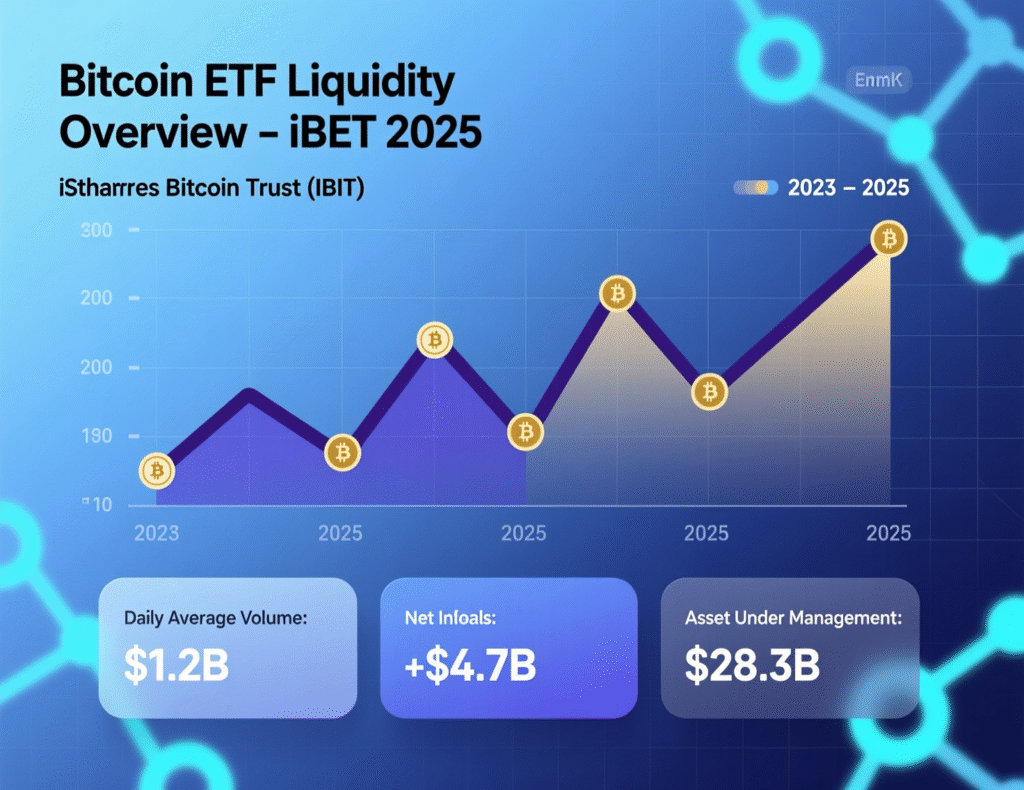Institutional-Grade Crypto
Institutional-grade crypto has moved from “pilot” to “program.” In 2025, hedge funds, pensions, endowments and increasingly sovereign wealth funds now access bitcoin and ether through regulated spot ETFs, institutional custody, and exchange-cleared derivatives. BlackRock’s iShares Bitcoin Trust (IBIT) is closing in on $100B AUM, a historic scale that signals mainstream portfolio inclusion and deep secondary-market liquidity.
At the same time, survey data show a decisive shift in intent: 59% of institutional investors plan to allocate over 5% of AUM to digital assets or related products. And sovereign wealth funds are beginning to move: Luxembourg’s FSIL publicly disclosed a 1% allocation to Bitcoin ETFs a first in the Eurozone and a watershed in policy signaling for state capital.
This guide distills what institutional-grade crypto means in practice across governance, custody, liquidity, risk, regulation, and reporting and maps concrete allocation paths for hedge funds through to sovereign wealth funds. You’ll find a pragmatic checklist, reference architectures, and case snapshots to de-risk design choices while aligning with frameworks like Basel’s crypto-exposure treatment and ADGM’s updated digital-asset regime.
What “Institutional-Grade Crypto” Really Means
Institutional-grade crypto is a standards-driven operating model that lets large allocators access digital assets with the same rigor they apply to public equities, fixed income, or commodities. Core dimensions:
Governance & Policy
Investment policy statements (IPS) that define eligible assets (e.g., BTC, ETH, tokenized T-bills), wrappers (ETF, ETP, SMA, fund), benchmarks, and rebalancing rules.
Risk Management
Market, liquidity, counterparty, operational, cyber, and compliance risks quantified with VaR/stress; Basel-aligned bank interactions for financing and collateral.
Custody & Controls
Qualified custodians, segregation of duties, SOC 2 / ISO 27001, MPC wallets, disaster recovery, and real-time reconciliation. (Examples: BlackRock’s IBIT uses Coinbase Prime as affiliate custodian partner; Fidelity Digital Assets custodies FBTC.)
Liquidity & Execution
Access across ETFs, CME futures/options, spot venues, RFQ/primes, with TCA and slippage controls.
Compliance & Reporting
KYC/AML, audit trails, NAV strikes, price sources (CME CF), board reporting.
Market Reality in 2025: Why Institutions Are Comfortable Now
Scale & Access
IBIT’s march toward $100B AUM demonstrates both demand and robust primary/secondary liquidity; comparable spot funds from Fidelity (FBTC) and others round out choice.
Demand Signals
In EY & Coinbase’s 2025 survey, 59% of institutions plan to allocate >5% AUM to digital assets; 83% plan to increase allocations.
Regulatory Clarity
Basel’s published chapter on cryptoasset exposures and regimes like ADGM’s 2025 updates reduce ambiguity for banks and allocators.
Sovereign Signposts
Luxembourg’s FSIL invests 1% via ETFs policy acceptance at the state-fund level.

Allocation Paths by Institution Type
Hedge Funds: Opportunistic to Multi-Strat
Use cases
Directional BTC/ETH, basis trades (ETF/futures), options overlays, alt-beta baskets, relative value, event-driven around protocol upgrades.
Typical wrappers
Spot ETFs for mandate-friendly exposure; CME futures for leverage and cash-settled hedging; segregated custody for active strategies.
Why now
Depth/liquidity and derivatives access; survey evidence of increased crypto allocations among hedge funds through 2024–2025.
Controls checklist (HF)
Prime brokerage with segregated collateral and rehypothecation controls
Daily independent pricing (CME CF), T+0 cash/position reconciliations, trade-level TCA
Counterparty scorecards across exchanges, RFQ desks, and clearers
Derivatives mandates aligned to risk limits (e.g., delta notional caps, Vega limits)
Pensions & Endowments: Programmatic, Low Friction
Use cases
1–3% policy sleeve in Institutional-Grade Crypto via spot ETFs to minimize ops complexity; tokenized T-bill funds for yield and settlement efficiency (policy-dependent).
Why now
ETF structure fits board oversight, transparent fees, familiar operational models.
Controls checklist (PE)
IPS addendum: eligible ETFs, liquidity tiers, rebalancing bands
Benchmark selection (e.g., CME CF BRR-NY) and tracking-error limits
Annual custodian due diligence; SOC 2 Type II attestation
Sovereign Wealth Funds: Strategic & Policy-Signaling
Use cases.
ETF pathway
(Luxembourg model): regulated exposure with minimized custody frictionIndirect exposure
Via public equities holding BTC on balance sheet (e.g., MSTR)—historically used by some SWFs as a bridge stepDirect + Co-Invest
Later stage data centers, tokenization platforms, or digital-asset exchanges in regulated hubs (e.g., ADGM), subject to national policy
Why now
Policy frameworks maturing; peer signaling (FSIL 1% allocation).

The Institutional-Grade Crypto Stack (People, Process, Tech)
Governance & Risk (H2: includes main keyword)
Board-level policy for institutional-grade crypto exposure
Asset scope, max weights, wrappers, liquidity SLAsRisk
VaR, stressed VaR with crypto-specific scenarios; pre-trade checks; daily factor attributionCapital & Collateral
Engage banking partners aligned to Basel’s crypto treatment (Group 1/2 assets, risk weights, add-ons).
Custody Architecture
Qualified Custodian with
Cold/warm MPC, role-based approvals, key-ceremony logs, SOC 2/ISO 27001, insurance, and segregated on-chain accountsETF Route
Leverage regulated fund custody (e.g., Coinbase Prime for IBIT; Fidelity Digital Assets for FBTC).
Liquidity & Execution
ETFs/ETPs for policy-friendly exposure and intra-day liquidity (IBIT nearing $100B).
Futures & Options (CME) for hedging, basis, and overlays
RFQ/Block for large spot; TCA to prove best execution
Compliance & Audit
KYC/AML at counterparties, travel-rule compliance for direct on-chain flows
Independent pricing (CME CF), NAV control, audit-ready logs
Regime mapping: MiCA (EU) for ETP issuers/custody; ADGM updates in 2025 for digital-asset activities; local licensing where applicable.
Case Snapshot #1: ETF-First Hedge Fund, Q1–Q3 2025
Mandate
2% NAV in institutional-grade crypto beta, options overlay ±50 bps tracking error
Implementation
Core via IBIT + FBTC; hedge with CME futures
Outcomes
Tight tracking, improved liquidity during rebalances; documented best-ex via TCA. IBIT depth/liquidity reduced implementation shortfall as AUM scaled toward $90B+.
Case Snapshot #2: Sovereign Wealth Fund (Luxembourg)
Mandate:
1% strategic allocation, ETF-only
Rationale:
Regulatory clarity, simplified custody, political risk management
Outcome:
Public disclosure catalyzed peer review; policy framework now a template for other EU SWFs. globalgovernmentfintech.com+1Deep-Dive: What Can Still Go Wrong?
Liquidity Gaps
Weekend moves; ETF/underlying dislocations manage with circuit breakers and “trade windows.”
Counterparty/Operational
Exchange outages; ensure multi-venue redundancy and warm-wallet runbooks.
Valuation
Use CME CF as primary; define fallbacks; document price challenge process.
Regulatory Drift
Track updates to Basel, MiCA RTS, and regional regimes (e.g., ADGM consultations on staking 2025).

Building Your Institutional-Grade Crypto Program (Step-by-Step)
Policy & Mandate Design
Define objectives (inflation hedge, diversification, uncorrelated return). Set max allocations, drawdown triggers, derivatives permissions.
Wrapper Selection (ETF vs Direct vs SMAs)
ETF/ETP
Fastest, highest governance fit; tight ops. (IBIT/FBTC scale supports liquidity.) Direct Custody
Needed for staking/active strategies; higher ops burden; use qualified, audited custodians.
SMAs / Funds-of-Funds
For specialized mandates or multi-manager diversification.
Counterparty & Custody DDQ
SOC 2 Type II, insurance, MPC details, key ceremonies, segregation proofs, incident history, service-level metrics.
Execution & Hedging
RFQ panels, algos, pre-trade risk; futures for beta/hedge; options for downside protection.
Reporting & Oversight
Board dashboards: exposures, VaR, slippage, realized/unrealized P&L, compliance flags.
Annual policy review; scenario drills and tabletop cyber exercises.
Advanced Topics for 2025
Tokenization & Cash Management
The emergence of tokenized T-Bills and money-market funds enables on-chain settlement with off-chain yields appealing for treasurers seeking instant collateral mobility. (Assess policy constraints and domicile risks.)
Nation-State & SWF Adoption Watch (H2: includes main keyword)
Luxembourg FSIL
1% via BTC ETFs (first Eurozone SWF to disclose)
Norway’s GPFG (NBIM)
Increased indirect bitcoin exposure via equities holding BTC, per 2025 analyses; SWFs globally manage ~$13–14T in assets.
Expect more ETF-based institutional-grade crypto allocations as regulatory clarity and ETF liquidity deepen.
Tools & Benchmarks You Can Trust
ETF Fact Pages: IBIT (AUM, benchmark, basket data).
Issuer-Custody Notes: Fidelity Digital Assets custody model for FBTC.
Surveys: EY/Coinbase Institutional Investor Survey 2025 for allocation intent.
Regulatory: BCBS Cryptoasset Exposures, ADGM framework updates and consultations.

Concluding Remarks
Institutional-grade crypto has matured into a repeatable operating model: defined policy, qualified custody, liquid wrappers, and audit-ready reporting. Hedge funds use it for basis and overlays; pensions and endowments prefer ETFs for governance fit; sovereign wealth funds are starting to allocate as Luxembourg’s FSIL illustrates signaling durable policy acceptance.
With Basel-level guidance, ADGM-style regimes, and ETF liquidity approaching blue-chip scale, CIOs can treat bitcoin and ether as program assets rather than experiments. The practical path is clear: start with ETF exposure sized to risk tolerance, industrialize controls, then expand to direct custody or tokenized instruments if policy and capability warrant. Build it once, govern it always that’s institutional-grade crypto.
CTA:
Want a tailored blueprint for your investment committee? Get our Institutional-Grade Crypto Program Pack policy templates, DDQs, and implementation checklists.
FAQs
Q : How do we start with institutional-grade crypto if our board is cautious?
A : Begin with a small ETF sleeve (e.g., IBIT/FBTC) governed by an IPS addendum, tracking a transparent benchmark (CME CF). This minimizes custody complexity and offers audit-ready reporting while you build risk and operations muscle.
Q : How much should hedge funds allocate initially?
A : Common practice is 0.5–2% NAV for beta, with derivatives overlays. Scale after demonstrating process-discipline, TCA, and drawdown management tied to risk-budget. (See hedge-fund adoption trends through 2024–2025.)
Q : How does custody for institutional-grade crypto differ from retail?
A : Institutions use qualified custodians with MPC, role-segregation, insurance, SOC 2 audits, and formal key ceremonies—plus independent pricing and reconciliation. ETF wrappers outsource most of this to the issuer’s ecosystem (e.g., Coinbase Prime, Fidelity DA).
Q : How can we hedge crypto exposure?
A : Use CME futures for beta control, options for tail-risk, and disciplined rebalancing around corridors. Document overlays and stress tests in the IPS. (Benchmarks: CME CF indices.)
Q : How do sovereign wealth funds approach crypto?
A : Most start with ETF exposure for policy optics and custody simplicity. Luxembourg’s FSIL disclosed 1% via BTC ETFs in Oct-2025, a model peers can examine.
Q : How does Basel treat bank crypto exposures?
A : BCBS sets prudential treatment for cryptoasset exposures—capital, risk weights, and classification informing bank relationships and financing terms.
Q : How can we prove ‘best execution’?
A : Adopt multi-venue RFQ, algorithmic execution with slippage limits, and produce TCA reports comparing fills to composite benchmarks.
Q : How do tokenized cash instruments fit?
A : They can improve settlement speed and collateral mobility. Start with limited pilots within your policy constraints and domicile rules.
Q : How can we measure adoption momentum?
A : Use ETF AUM (e.g., IBIT trending toward $100B) and institutional surveys (EY/Coinbase) as leading indicators alongside your own liquidity screens.

